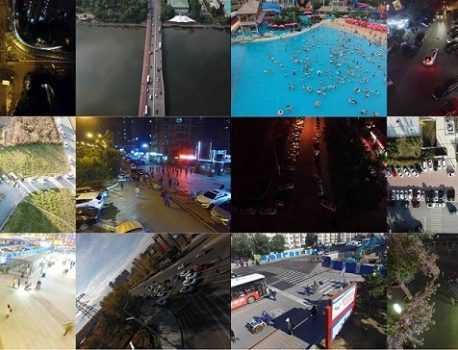Overview
- We are pleased to announce the VisDrone 2023 Object Detection in Images Challenge (Task 1). This competition is designed to push the state-of-the-art in object detection with drone platform forward. Teams are required to predict the bounding boxes of objects of ten predefined classes (i.e., pedestrian, person, car, van, bus, truck, motor, bicycle, awning-tricycle, and tricycle) with real-valued confidences. Some rarely occurring special vehicles (e.g., machineshop truck, forklift truck, and tanker) are ignored in evaluation.
- The challenge containing 10,209 static images (6,471 for training, 548 for validation and 3,190 for testing) captured by drone platforms in different places at different height, are available on the download page. We manually annotate the bounding boxes of different categories of objects in each image. In addition, we also provide two kinds of useful annotations, occlusion ratio and truncation ratio. Specifically, we use the fraction of objects being occluded to define the occlusion ratio. The truncation ratio is used to indicate the degree of object parts appear outside a frame. If an object is not fully captured within a frame, we annotate the bounding box across the frame boundary and estimate the truncation ratio based on the region outside the image. It is worth mentioning that a target is skipped during evaluation if its truncation ratio is larger than 50%. Annotations on the training and validation sets are publicly available.
- Note that the top three contestants need to provide the final training code. We will use this code to reproduce the results.
Dates
- [06.01]: Training, validation and testing data will be released
- [06.15]: Dataset available for download and start to submit result
- [07.15]: Results submission deadline
- [10.03]: Challenge results released
- [10.03]: Winner presents at ICCV 2023 Workshop
*All times are at GMT – Greenwich Mean Time
*The deadline for the competition is 24:00 on July 15th 2023, GMT time
Challenge Guidelines
- The object detection evaluation page lists detailed information regarding how submissions will be scored. To limit overfitting while providing researchers more flexibility to test their algorithms, we have divided the test set into two splits, including test-challenge and test-dev.
- Test-dev (1,610 images) is designed for debugging and validation experiments and allows for unlimited submission. The up-to-date results of the test-dev set are available to view on the leaderboard.
- Test-challenge (1,580 images) is used for workshop competition. We encourage the participants to use the provided training data, while also allow them to use additional training data and pre-trained models. The use of external data and pre-trained models must be indicated during submission.
- The train+val images and corresponding annotations as well as the images in the test-challenge set are available on the download page. Before participating, every user is required to create an account using an institutional email address. If you have any problems in registration, please contact us. After registration, the users should submit the results in their accounts. The submitted results will be evaluated according to the rules described on the evaluation page. Please refer to the evaluation page for detailed explanation.
Tools and Instructions
We provide extensive API support for the VisDrone images, annotation and evaluation code. Please visit our GitHub repository to download the VisDrone API. For additional questions, please find the answers here or contact us.


